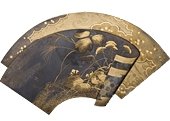MEIJI
dal 13/4/2009 al 3/10/2009
Segnalato da
13/4/2009
MEIJI
MAK Austrian Museum of Applied Arts / Contemporary Art, Wien
Japan around 1900. The exhibition presents a selection of 90 ceramic, bronze, lacquerwork, and porcelain objects created between 1870 and 1912, but also purchased for or donated to the then Museum of Art and Industry (today's MAK) in that same period. Particularly illuminative is the comparison between "official" objects donated by Japanese state institutions and others that came to the museum through private donations. Curated by Johannes Wieninger.

curated by Johannes Wieninger
The beginnings of the Japanese collection 140 years ago and,
contemporaneously, the establishment of diplomatic relations between Japan
and Austria provide the starting point and the occasion for the exhibition
“MEJI. Japan around 1900” shown at the MAK Collection Asia.
The exhibition presents a selection of 90 ceramic, bronze, lacquerwork, and
porcelain objects created between 1870 and 1912, but also purchased for or
donated to the then Museum of Art and Industry (today’s MAK) in that same
period. Particularly illuminative is the comparison between ‘official’ objects
donated by Japanese state institutions and others that came to the museum
through private donations.
From 1869 to 1871, the Austro-Hungarian monarchy had sent out the
“Imperial and Royal East Asian Expedition” to China, Siam, and Japan to set
up diplomatic relations between these countries and Austria. Arthur von Scala,
an expert of the then Museum of Art and Industry, took part in the expedition
on which the first Japanese items were acquired for the museum—of which
only very few are still extant in the MAK collection.
Under the governmental motto of “Meiji” (Enlightened Rule), the only 16-yearold
Tenno (Emperor) Mutsuhito (1852–1912) took over government in 1868,
leading Japan from a feudal system into a constitutional monarchy after the
Western model.
This induced fundamental economic and social changes as well as an
intensification of international relations in several respects: the Meiji Tenno
transferred the imperial capital city from Kyoto to Edo which was renamed into
Tokyo in 1868, transformed the Samurai system into a regular army system,
and made the country follow Western ideals.
The 1873 Vienna World’s Fair where Japan first presented itself to Europe as
a nation with a broad range of products, offered a variety of interesting art and
crafts pieces, many of which were later donated by the Japanese government
to several European museums, including today’s MAK. Prior to the World’s
Fair, Japan had made an effort to manufacture products to the European
taste, though with little success. So the decision was made that the country
should present itself in Vienna with products based on its own tradition.
One highlight of the show is a fan-shaped lacquerwork piece by Ikeda Taishin
(1829–1903), which, in 1873, was appreciated with enthusiasm in Vienna. As
for centuries before people were impressed by the delicacy and diversity of
materials—above all, by the gold sprinkling (maki-e) on dark lacquer.
One of the most eminent Japanese porcelain painting artists featured in the
show is Kawamoto Masukichi (1831–1907) from Seto. He created a porcelain
painting of Mount Fuji. On the one hand, he thus continued the great tradition
of Fuji pictures in the manner of Katsushika Hokusai; on the other, the painting
shows that it was possible to continue an independent tradition while not
rejecting Western influences altogether. After the end of the World’s Fair, the
porcelain painting was presented to the Museum of Art and Industry as a gift
from the Japanese government.
Another donation made to today’s MAK by the Japanese government after the
Vienna World’s Fair of 1873 is a large state vase with reliefs showing scenes
from Japanese history (today a companion piece is in the Tokyo National
Museum). A comparison of this stately bronze piece with two vases purchased
by the museum at the 1901 Glasgow International Exhibition makes a
development of the language of forms discernible in the course of the Meiji
era: a more generous line in form and decoration was more to the European
taste. Pieces like these became key works of Japonism.
Following the World’s Fair, the “Oriental Museum” was founded in 1874, its
main mission being the advancement of trade relations between Asian
countries and the Austrian monarchy. Its collection was complemented 1892
with substantial donations by Heinrich Siebold and Hermann Mandl, which
also included, aside from historically significant items, contemporary
lacquerwork, ceramics, and bronzes; 1907, the holdings were taken over by
the Museum of Art and Industry.
Many of the works exhibited in the show were previously presented in
international exhibitions, while others, mostly donations from travelers to
Japan, are show for the first time here. These sometimes strange-looking
objects attest to the taste of the epoch and to a frequently very personal
interest in the then far-away country.
MAK Press Office
Monika Meryn
Olivia Harrer
Phone (+43 1) 711 36 229 - Fax (+43 1) 711 36 227 E-Mail presse@MAK.at
Press Preview Tuesday, April 14, 2009, 10:30 a.m.
Opening Tuesday, April 14, 2009, 7:00 p.m.
MAK
Stubenring 5 - Wien
Opening Hours Tue MAK NITE© 10:00 a.m.–12:00 p.m., Wed–Sun 10:00 a.m.–6:00 p.m., Mon closed
Admission euro 9.90 with MAK Guide / euro 7.90 / reduced euro 5.50
Free Admission on Saturdays



